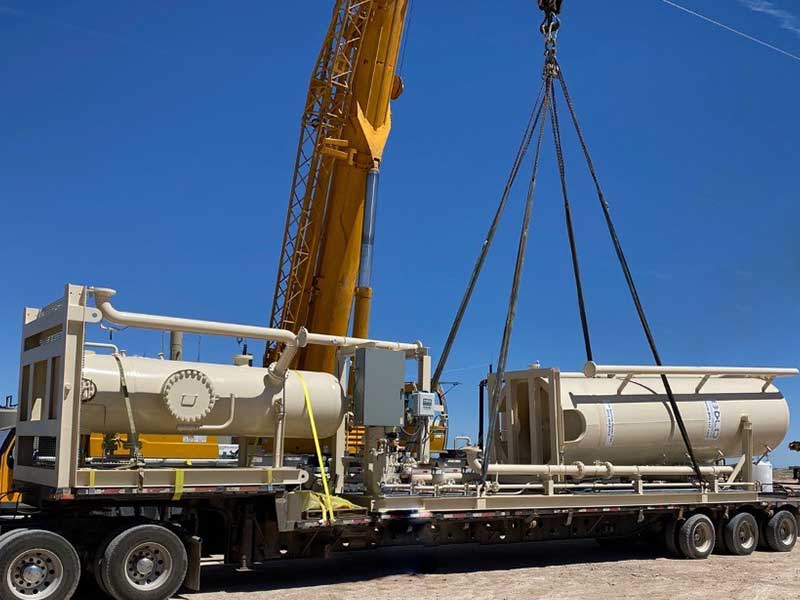Purpose of the FLEX
Bold developed the FLEX (Flare Extinguisher) as a solution to decrease emissions on H2S treating locations during preventative maintenance or any upset scenario. The FLEX is a trailer mounted horizontal treater filled with a static bed of SGT-281. The FLEX can be included as part of the initial installation at the production facility or can easily be transferred in and out as needed.
Preventative maintenance is needed periodically on all equipment operated with non-regenerative H2S scavengers to remove byproducts and any contaminants from the vessel. Routine preventative maintenance also ensures maximum treating efficiency throughout operations. Our team has optimized the time between maintenance specifically for our equipment. The frequency between maintenance dates is based on the pounds of sulfur produced by the well and size of Bold’s Continuous Treating Systems (CTS) or other H2S scavenging equipment that is treating the gas.
Operations
Bold forecasts maintenance dates based on operating conditions, which helps our customers with budgeting for the year. At the time of maintenance, the FLEX is mobilized to location, if not already installed, and placed in series to Bold’s permanent H2S treating vessel, the CTS. The sour gas flows through both the CTS in series with the FLEX. Once the FLEX bed temperature is equalized with the CTS bed temperature, the CTS is bypassed and treating continues through the FLEX. The CTS is then depressurized, and the preventative maintenance process begins. Once completed, the process is reversed, the CTS is put back in service, and the FLEX is bypassed.
Impact of the FLEX on Customers
When a traditional preventative maintenance is needed, the customer must bypass the H2S treating vessel and send the sour gas to flare. Our FLEX solution allows customers to continue to sell gas throughout the maintenance process without sending sour gas to flare. This accomplishes four things:
- Increased revenue from selling gas during maintenance
- Decreased emissions
- More predictable production forecast
- Savings on permits needed to flare gas
Below is an example of a Bold treating application with the simulated emissions eliminated. The operating conditions and gas analysis used in the simulation are from one of Bold’s treating sites in the Permian Basin.
Table 1. A treating application for Bold
| Gas flow rate | 1.5 MMSCFD |
| H2S concentration | 3,800 ppm |
| Bold’s leased equipment | 72” CTS |
| SGT-281 pump rate | 473 gallons per day |
Bold’s 72” CTS can remove 25,000 pounds of sulfur from a gas stream before needing maintenance. In this application, the 72” CTS would need maintenance approximately every 2 months assuming no production upsets or other downtime from the well or pipeline.
A typical maintenance of a 72” CTS takes 12-48 hours. This entire maintenance period lasted approximately 24 hours from initial bypass into the FLEX to bringing the CTS back into full service. The simulated emissions assumed a flare combustion rate of 98%. Without the FLEX, the gas would be sent to flare which would result in the following emissions:
Table 2. Emissions Saved using the FLEX
| NOx | 753 | Lb/day |
| SOx | 960 | Lb/day |
| Volatile Organic Compounds (VOCs) | 535 | Lb/day |
| Greenhouse Gases (GHGs) | 2.433 * 105 | Lb/day |
The total emissions eliminated using the FLEX was 245,552 lbs. for this maintenance cycle.
Assuming 6 preventative maintenance events throughout the year, this results in 736 tons of emissions saved per year.
Other than decreasing emissions, the FLEX also increases revenue from selling gas during maintenance. At $4 / MMBtu and a gas flow rate of 1.5 MMSCFD, the FLEX resulted in $6,240 of revenue in additional gas sales for that 24 hour maintenance period.



